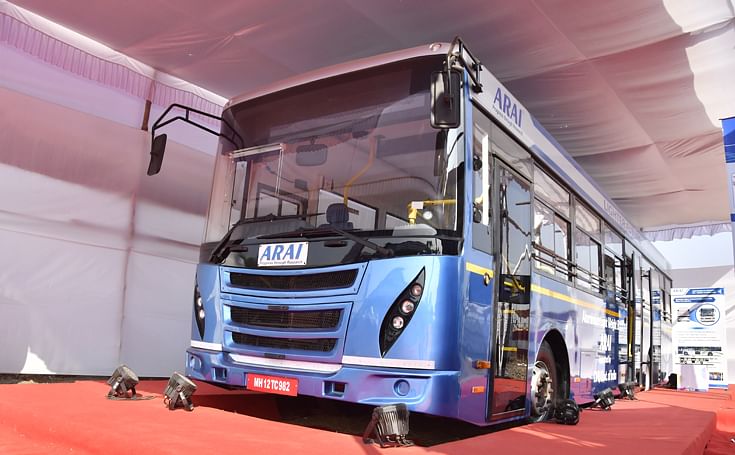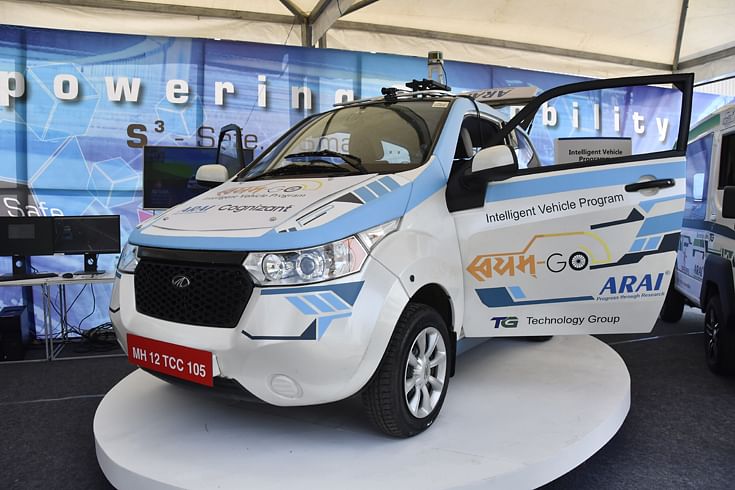Rashmi Urdhwareshe: 'We can give all ARAI-developed tech to start-ups, which will enable them to scale up their production.'
Rashmi Urdhwareshe, Director of ARAI, on efforts underway at lightweighting, developing new propulsion technologies, and driving towards an integrated transportation system.
As India Auto Inc upgrades to new emission and safety norms, while also drawing the e-mobility roadmap, the role of testing and validation becomes even more vital. Rashmi Urdhwareshe, Director of the Automotive Research Association of India (ARAI), speaks to Sumantra B Barooah on ARAI’s efforts at lightweighting, developing new propulsion technologies, and driving towards an integrated transportation system.
We understand ARAI has been working on new lightweighting technologies. Is it composites or anything beyond that as well?
We have developed an aluminium superstructure for buses, which provides about 30 percent weight reduction and contributes greatly to vehicle electrification. This technology is now available and is being discussed with several manufacturers. Other areas we are working on include suspension and some other components. We are also pushing for development of alternate materials.

ARAI showcased this aluminium-bodied lightweight bus at SIAT 2019. The 30% weight reduction over a conventional bus will prove beneficial for e-mobility.
What is the scope of ARAI's MoU with Bharat Heavy Electricals Ltd?
With ARAI and BHEL being two organisations under the Heavy Industries Ministry, this MoU was seen as an opportunity to work together. ARAI has its strengths for developing technology and domain knowledge with respect to electric mobility, while BHEL is proficient in power electronics and manufacturing capability. Through this collaboration, we will leverage charging infrastructures and
our technology for lightweight buses.
In an era of e-mobility, what do you think Indian OEMs should do to be at par with foreign MNC OEMs, or take a global lead?
India has an advantage of scale, covering all vehicle segments from two-wheelers to buses and trucks. In my view, success will lie in public transportation with the government promoting it through policies and infrastructures. That is something vehicle manufacturers should cash on now. Under the new FAME II scheme, there are some big announcements such as deploying of over 5,000 e-buses. Electric thre-wheelers are also proving to be very relevant today, especially with the rising development of smart cities. I think the market will drive adoption of electric passenger cars and buses, not government policy.
Do you think Indian OEMs have an inherent advantage in the two- and three-wheeler segments, especially in the domestic market?
Yes. But currently the entire effort is going into the development of BS VI powertrains as the April 2020 deadline is fast approaching. After BS VI, we can expect much more growth in electrification programmes, which is sort of a national priority now.
Localisation of EV technologies looks to be a major challenge. Is ARAI developing any solutions, for BMS or even battery technology in addition to what it has done with ISRO and BHEL?
I think more than a hurdle, it's an opportunity. There are different industries which are coming up. ARAI is positioning itself as the testing and validation arm for various organisations. With incentives, there are good opportunities for start-ups here. We can give all the technologies developed inside ARAI to start-ups, which will enable them to scale up their production. We are not in a space where we go into any sort of production.
What are the steps that should be taken to ensure absolute safety in electric mobility?
It has to be handled in multiple ways. One is at the vehicle construction level. Obviously, the crash- related regulations specifically address the crash compatibility of EVs at the component level. Even the charging temperatures going higher than what are prescribed are very detrimental for batteries and need to be controlled. From that point of view, solutions such as swappable battery systems are being talked about. We have to also ensure that the charging happens in a controlled environment. We are also looking at training people in maintenance, running the vehicles and even the first responders, who should know how to handle a fire. So EVs have some unique requirements when it comes to safety.
Any new energy source is always associated with uncertainties. For instance, hydrogen in vehicles was always seen as a hazard initially. Thus, what comes along is tightening of safety norms, introduction of new user interfaces and training or re-training of people to handle these technologies.
Is the government looking to draft an EV-specific regulation in the realm of safety?
The basic regulations are very much in place and based on them, testing and approval takes place at ARAI. There are component level tests, which are performed on critical components like batteries. For instance, the nail penetration test to assess battery design integrity. There are vehicle installation level tests; while charging an EV, there should not be any short circuit.
Along with crash tests, there are several other tests with respect to the handling of electric power on an EV because the vehicle is connected to the road only by tyres. Here the tyres act as insulators, and the vehicle doesn't see any grounding. That’s something one has to be mindful of, with the electric charge being utilised on the vehicle for the purpose of propulsion.
The government is also talking about ethanol, methanol and hydrogen. What is the government's thought process when it comes to new propulsion technologies beyond electric mobility?
I would not like to comment on the government's perspective but would focus my thoughts on how ARAI looks at it. From a technocrat point of view, we are agnostic to any fuel and we are examining all the possibilities. ARAI has worked on ethanol and successfully completed a research project for assessing E20 — 20 percent of blending in petrol. Similarly, we are also working on methanol, where up to 15 percent blending has been successfully tried out on two- and three-wheelers as well as on passenger cars. All these fuel or blending possibilities also open up the opportunity for use of alternate fuels to reduce India’s dependency on imported fuel.
What is the current status on the use of hydrogen as a mobility fuel?
There are clearly two ways in which hydrogen can be utilised — the fuel cell route and using hydrogen purely as a fuel on the go. The first route, obviously, is the long route and after the success of EVs, the fuel cell is the natural route. At ARAI, we are now setting up a capability for evaluation of fuel cell-based vehicles that will come up in our Chakan facility in the near future.
The second route is of using hydrogen directly as a fuel and one experiment has been tried out in blending hydrogen in CNG. Up to 18 percent blending has been tried out and the report is also available with us. That basically enables us to continue using CNG-converted vehicles by putting additional hydrogen, which is much cleaner than pure CNG and also increases the utilisation of hydrogen in a stepped manner. Obviously, some fine-tuning is required in the powertrain. At up to 18 percent, there is no need for any change in the cylinder and you don't need any major modifications in the fuel handling systems. Keeping this advantage in mind, it can be tried out in cities where the CNG network is already available.
Along with emissions, safety is another area where India Auto Inc is set to take a big leap from October. The Motor Vehicle Amendment Bill has been passed recently. Do you think it will help reduce India's dubious road fatalities record?
The purpose of these safety regulations is to address the concerns about occupant safety and about road safety to a large extent. At ARAI, we have carried out more than 300 crash tests. Several models have already been tested and approved. In my view, that is not going to be sufficient. Enforcement is something we should look at. We have the advantage of IoT and connectivity, which will enable the user to be much more informed and take appropriate decisions while driving.
In which direction do you see the Indian auto industry heading?
I believe we have already hit the bottom and the industry is struggling on multiple fronts. The focus is very clearly shifting towards developing an ecosystem for public transportation. There is an integrated transportation system, which is also being talked about. Our focus is not to have more vehicles on the road, but towards giving efficient transportation models to the user. That is the transportation goal we should aim at. The priority will always be there for bringing in more efficient, connected and safer vehicles. That's where I think we are heading. Electrification is just one of the priorities, crash compatibility is just another requirement, and BS VI another regulation. But ultimately, we are moving towards a safe, sustainable and cleaner environment and transportation sector.

ARAI's upcoming 110-acre Mobility Research Centre at Takwe near Pune will house a state-of-the-art test track for autonomous vehicles, tyre and wheel R&D, a fire safety research lab, hydrogen and fuel cell technology centre, hydrogen dispensing station and cylinder testing facility.
What are the new projects or facilities ARAI is investing in? How do you rate India's automotive testing and validation capability?
We have announced our fourth centre in January during SIAT 2019. The new centre will be at Talegaon, near Pune and its focus will be on mobility research areas including fire safety and efficient energy conversions. It will house an Energy Lab along with a setup to meet the fire safety requirements for mobility, today and tomorrow.
Another focus area is to address the off-road vehicle-related requirements. Currently, these vehicles are to a certain extent governed under the Motor Vehicle Act, but there are safety and emission-related roadmaps drawn up for that sector. We are setting up a Centre of Excellence at our fourth centre with DHI support.
Our teams are trained not just for testing and homologation for Indian requirements but are also accredited for export homologation. We regularly track the gaps that exist between global and Indian regulations. We help the government in bridging those gaps and in setting up the standards. We also invest heavily from our side on new facilities that are required. Currently, after NATRiP, there is nothing coming our way, and there is hardly any plan announced by the government. We need to create a fund to support these activities and we can’t do it on our own. That's where I am a little bit concerned. Other than that, on capacity-wise and facility-wise, we are ready and we are at par (globally).
Can a vehicle, right from ground up through to commercial launch, get all the necessary testing and validation services done at ARAI?
Yes, we have been doing it. It is just that people don't know that a particular vehicle has been developed at the component level or system level at ARAI. In fact, many MNCs use our facilities. A lot of validation is done at ARAI before the products are introduced in Indian markets, and vice-versa. We also do it for global customers when they introduce their new products elsewhere in the world.
This interview was first published in Autocar Professional's September 1 print edition
RELATED ARTICLES
India: A Bastion Of Stability for Schaeffler
German autoparts maker Schaeffler’s CEO, Klaus Rosenfeld, describes India’s role in the company’s €24-25 billion empire....
'No Question of Us Being Late' - Suzuki India on e-2Wheeler Market
Suzuki Motorcycle India believes its EV entry is timely as the market is now mature enough to grow off genuine demand ra...
'India Can Become a Major Pillar for Us' - Marquardt Group
Björn Twiehaus, CEO of Marquardt Group, and Vishal Narvekar, the company's India GM, share their outlook on the Indian m...





 04 Oct 2019
04 Oct 2019
 33184 Views
33184 Views





 Ketan Thakkar
Ketan Thakkar


 Angitha Suresh
Angitha Suresh

 Darshan Nakhwa
Darshan Nakhwa

